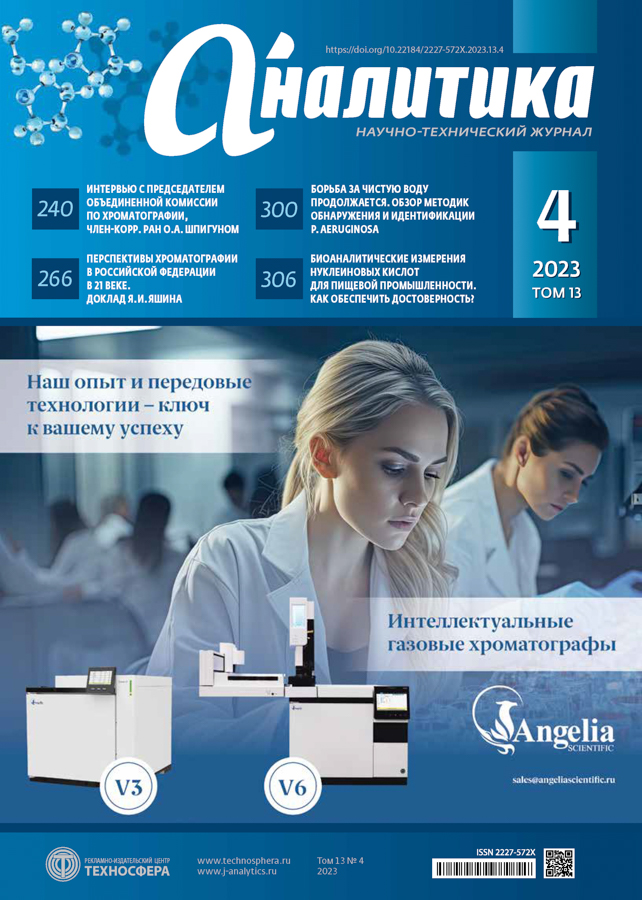Assurance of Bioanalytical Measurements Reliability for Nucleic Acids in the Food Industry
- Authors: Runov A.L.1, Vonsky M.S.1
-
Affiliations:
- All-Russian Research Institute of Metrology named after D.I. Mendeleev
- Issue: Vol 13, No 4 (2023)
- Pages: 306-309
- Section: Метрология химического анализа
- URL: https://journals.eco-vector.com/2227-572X/article/view/631383
- DOI: https://doi.org/10.22184/2227-572X.2023.13.4.306.309
- ID: 631383
Cite item
Abstract
Bioanalytical measurements of nucleic acids are applied to the most important challenges in the food industry. The international comparability of measurements is the basis for international trade. International cooperation of metrological institutes ensures comparability of measurements including nucleic acid analysis.
- I. Mendeleyev Institute for Metrology works on creation of the state primary standard of DNA sequence copy number unit, which will allow to provide metrological traceability of nucleic acids measurement results at the national level. To meet the needs of analytical laboratories, reference materials of nucleic acid composition will be created.
Keywords
Full Text
About the authors
A. L. Runov
All-Russian Research Institute of Metrology named after D.I. Mendeleev
Author for correspondence.
Email: a.l.runov@vniim.ru
Russian Federation, Saint Petersburg
M. S. Vonsky
All-Russian Research Institute of Metrology named after D.I. Mendeleev
Email: a.l.runov@vniim.ru
кандидат биологических наук
Russian Federation, Saint PetersburgReferences
- Семеко Г. В. Мировой продовольственный рынок: современные вызовы и перспективы. Экономические и социальные проблемы России. 2023; 1:19–43. doi: 10.31249/espr/2023.01.01. Semeko G. V. World Food Market: Current Challenges and Prospects. Jekonomicheskie i social’nye problemy Rossii – Economic and social problems of Russia. 2023; 1:19–43. doi: 10.31249/espr/2023.01.01.
- National Metrology Systems. Developing the institutional and legislative framework. BIPM, 2021. Available at: https://www.bipm.org/documents/20126/42177518/National-Metrology-Systems.pdf.
- Минаев М. Ю., Фомина Т. А., Махова А. А. Особенности отбора пищевой продукции для молекулярно-диагностических исследований. Всё о мясе. 2019; 5:28–30. doi: 10.21323/2071-2499-2019-5-28-30. Minaev M. Ju., Fomina T. A., Mahova A. A. Sampling Features of Food Products for Molecular Diagnostic Studies. Vsjo o Mjase – All about Meat. 2019; 5:28–30. doi: 10.21323/2071-2499-2019-5-28-30.
- Sajali, N., Wong, S.C., Hanapi, U.K et al. The challenges of DNA extraction in different assorted food matrices: a review. Journal of Food Science. 2018; 83:2409–2414. doi: 10.1111/1750-3841.14338.
- Pfeiffer F., Gröber C., Blank M. et al. Systematic evaluation of error rates and causes in short samples in next-generation sequencing. Sci Rep. 2018, 8:10950. doi: 10.1038/s41598-018-29325-6.
- Zook J., Catoe D., McDaniel J. et al. Extensive sequencing of seven human genomes to characterize benchmark reference materials. Sci Data. 2016; 3:160025. doi: 10.1038/sdata.2016.25.
- Artika I. M., Dewi Y. P., Nainggolan I. M., Siregar J. E., Antonjaya U. Real-Time Polymerase Chain Reaction: Current Techniques, Applications, and Role in COVID-19 Diagnosis. Genes. 2022; 13:2387. doi.org: 10.3390/genes13122387.
- Whale A. S., Jones G. M., Pavšič J. et al. Assessment of Digital PCR as a Primary Reference Measurement Procedure to Support Advances in Precision Medicine. Clin. Chem. 2018; 64(9):1296–1307. doi: 10.1373/clinchem.2017.285478.
- Yoo H. B., Park S. R., Dong L., et al. International Comparison of Enumeration-Based Quantification of DNA Copy-Concentration Using Flow Cytometric Counting and Digital Polymerase Chain Reaction. Anal Chem. 2016; 88:24:12169–12176. doi: 10.1021/acs.analchem.6b03076.
- Mester Z., Corbisier P. et al. Final report of CCQM-K86.c Relative quantification of genomic DNA fragments extracted from a biological tissue. Metrologia. 2020; 57(1A):0804. doi: 10.1088/0026-1394/57/1A/08004.
Supplementary files






